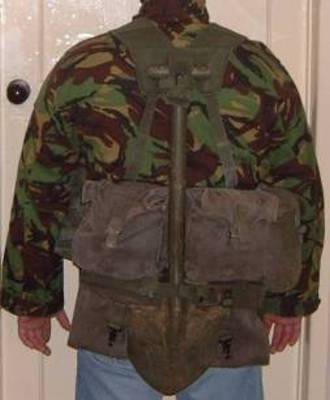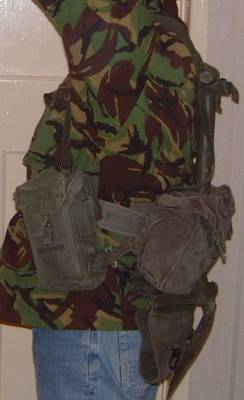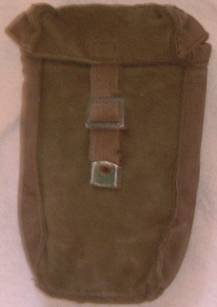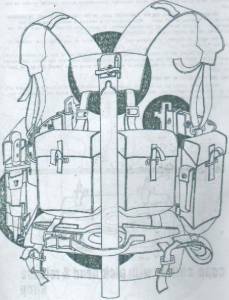 |
Pattern 58 webbing was designed in the 1950s the idea being it would be more suitable for mechanised infantry than p37 and p44 which was to cause problems later in the Falklands war which was not a mechanised war, it was issued in 1960 but it was to take some years before it totally replaced all the p37 and p44, the designers of p58 assumed that the troops would not have to march long distances with full marching order, they concentrated on making a set of equipment that would contain a fighting load well and above which a field pack could be perched for short marches.
The two orders for wear are called combat equipment fighting order [CEFO] and combat equipment marching order [CEMO], the items to be carried in CEFO included ammunition pouches 4 full SLR magazines [80 rounds] 1 belt of 50 rounds g.p.m.g ammo 2 grenades bayonet and scabbard weapon cleaning kit, kidney pouches,mess tin, combat ration, knife/fork/spoon, washing and shaving kit, foot powder, spare socks, housewife, towel, spare laces, poncho in roll, full water bottle and mug, lightweight pick or shovel, sandbag, respirator and NBC gear.
Carried in the field pack when CEMO was ordered were beret, cap comforter, drawers, parka, shirt, socks,towel gloves, boot cleaning kit, pt shoes, boots dms, sleeping bag.
The main feature of p58 is the yoke a padded shoulder harness that distributes weight comfortably. This attaches to a waist belt supporting ammo pouches a water bottle and NBC gear on the sides, and a pair of kidney pouches at the rear.
Below these is a poncho roll. The bayonet is held in loops on the inner face of the left ammo pouch.
The webbing from which the p58 equipment is made is stronger and more durable than that of the p44 also it has steel furniture. Its main drawback is the design fault which does not permit the carriage of a rucksack, pack, radio etc on the back with comfort, plus in arctic conditions when wet it froze, these drawbacks showed up starkly in the Falklands war, resulting in its eventual replacement by the pattern 90.
The first picture showing C.E.F.O order from the back the yoke, shovel, kidney pouches, and poncho roll,
ether pick or shovel could be carried. The head of the pick fits into pockets on the poncho roll.The second picture shows C.E.M.O order from the back.
The sleeping bag is missing which would be rolled up on top of the backpack. The the third picture shows the right side.Note the pocket on the
side of the ammunition pouch. Next to the ammunition pouch is the water bottle and mug carrying pouch.
The forth picture shows the Left side note the bayonet holding loops on the side of the left hand ammunition pouch.There is a error in two of the pictures showing the equipment from the back. The poncho roll is is the wrong way round. Thanks to Bill Neill for a lot of the following information. |
Patt 58 belt. To adjust the belt to different sizes there are hooks on each end of the belt which slot into the holes shown . Note the two metal rings which are used for the poncho roll to attach to. |
 |
 |
Patt 58 yoke.
The straps at the front of the yoke thread through the loop at the top of the ammunition pouch's and back up to the buckles at the top of the yoke .
The rings at the top of buckles are for attachment of the back pack. The second picture shows the ends of the back straps and what look like in any other pattern brace attachments but these are
smaller than other patterns and part of the yoke. they also fit on the back of the belt. The third picture shows the padded shoulders. Note the flap with the stud and cross strap which holds the the handle of the spade or pick axe in place wile in C.E.F.O order.
The stud fits into a hole in the handle of the spade or pick axe. The back pack straps go through the two webbing loops on the shoulders and attach to the rings just above the buckles. |
Patt 58 right hand ammunition pouch first and second picture.Note the quick release fasteners and the pocket on the Side of the ammunition pouch which was intended to hold the grenade launcher attachment but was generally used for personal items. Patt 58 left hand ammunition pouch third and forth picture. Note the loops on the side for the bayonet. The rings at the top are for the front yoke straps to thread through and the bottom side rings are for the poncho roll to attach to. |
Patt 58 kidney pouch's. Double pouch's worn at the back. The second picture shows the reverse of the pouch's and the third picture shows the fairly complicated way it all comes together note how the belt and yoke braces fit into it . The forth picture showing on the inside of the lids there are open ended pouch's were I am told by one old soldier that he used to keep his extra boot lacers. |
Patt 58 Water bottle and mug plus water bottle pouch. The bottle is dated 1972 and the mug 1974. The pouch has a strap and buckle fastener and a drainage hole at the bottom. Note the pocket on the inside of the lid in the forth picture which is were the sterilization tablets are kept. |
Patt 58 poncho roll. Obviously for keeping the poncho in but I am also told they sometimes rolled up the N.B.C. Suit in there as well as there was not enough room on the belt. The roll hangs from the back of the belt using the hooks on the rear of the poncho roll shown in the second picture. On the front of the roll starting at the top are two pockets the length of the roll which house the head of the pick axe. Either side of the roll are hooks which attach to the ammunition pouch's. Below the quick release fasteners are three rings to adjust the size of the roll. |
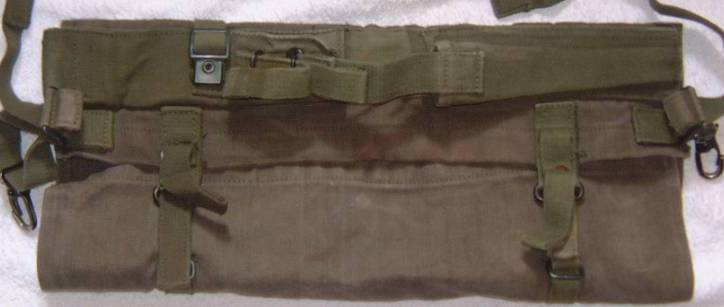 |
 |
Patt 58 field pack. The field pack has two side pouch's and one large compartment inside. Looking at the front of the pack first picture starting from the top two straps for the sleeping bag, two cross straps one sliding through a loop at the back of the other and fastening to two buckles at the bottom of the pack to hold the helmet and to make the pack secure, a carrying Handel, a studded flap and strap the same as the yoke to hold the pick axe or shovel handle and two straps and hooks at the bottom on either side which attach to the top ammunition pouch rings. The rear of the pack second picture note the two straps and hooks which go over the shoulders through the web loops on the yoke then attach to two rings just above the buckles on the front of the yoke. |
Patt 58 Compass pouch dated 1977.
Note the twist fastener and also note on the third picture showing the back the single metal belt attachment and the loop at the top
which I assume is used to attach it to the yoke similar to the pattern 37 and 44 webbing compass pouch's. |
 |
 |
patt 58 butt pouch . Dated 1972 it has the usual belt attachments on the back plus
a belt loop. I am told it was used as part of the special forces belt kit to rest the rifle butt in. |
Patt 58 binocular case.
Note the twist fastener also note on the second picture showing the back the double metal belt attachment
and the loop at the top which I assume is used to attach it to the yoke. |
Pattern 58 pistol holster for the 9mm Browning pistol.
Note the two pockets on the inside the longer one on the right is for the cleaning rod and the shorter one on the left is for the spare magazine.
Also note the loop at the bottom of the holster for the attachment of the poncho-roll hook. |
Patt 58 pick axe.The pickaxe shaft is attached to the yoke with the stud and cross strap
the same as the handle of the spade wile in C.E.F.O order.
The stud fits into a hole in the metal part of the shaft the other end of the shaft goes through the pick axe head
which is attached to the front of the poncho roll in the pockets provided. |
Machete sheath dated 1976. |
|
 BACK TO MILITARY EQUIPMENT BACK TO MILITARY EQUIPMENT |
|

